MGT101 - Introduction to Human Resource Management Essay
VerifiedAdded on 2022/09/26
|10
|2899
|37
Essay
AI Summary
This essay, prepared for the MGT101 Introduction to Human Resource Management course, delves into the core concepts and functions of HRM within the context of New Zealand organizations. The essay begins by highlighting the crucial role of HRM in organizational success, emphasizing its contribution to building motivated, skilled, and flexible teams, fostering organizational development, and maintaining positive employee relations, with specific examples from Spark NZ. It then explores key HRM functions, including HR planning, induction, talent management, performance management, and remuneration, detailing their significance and practical applications. The essay further examines the process of staffing, including recruitment and selection, as vital components of effective HRM. The content covers various recruitment methods, from internal to external sources, and the selection processes such as knowledge tests and reliability tests. Overall, the essay provides a comprehensive overview of HRM principles and practices, demonstrating their importance in achieving organizational goals.
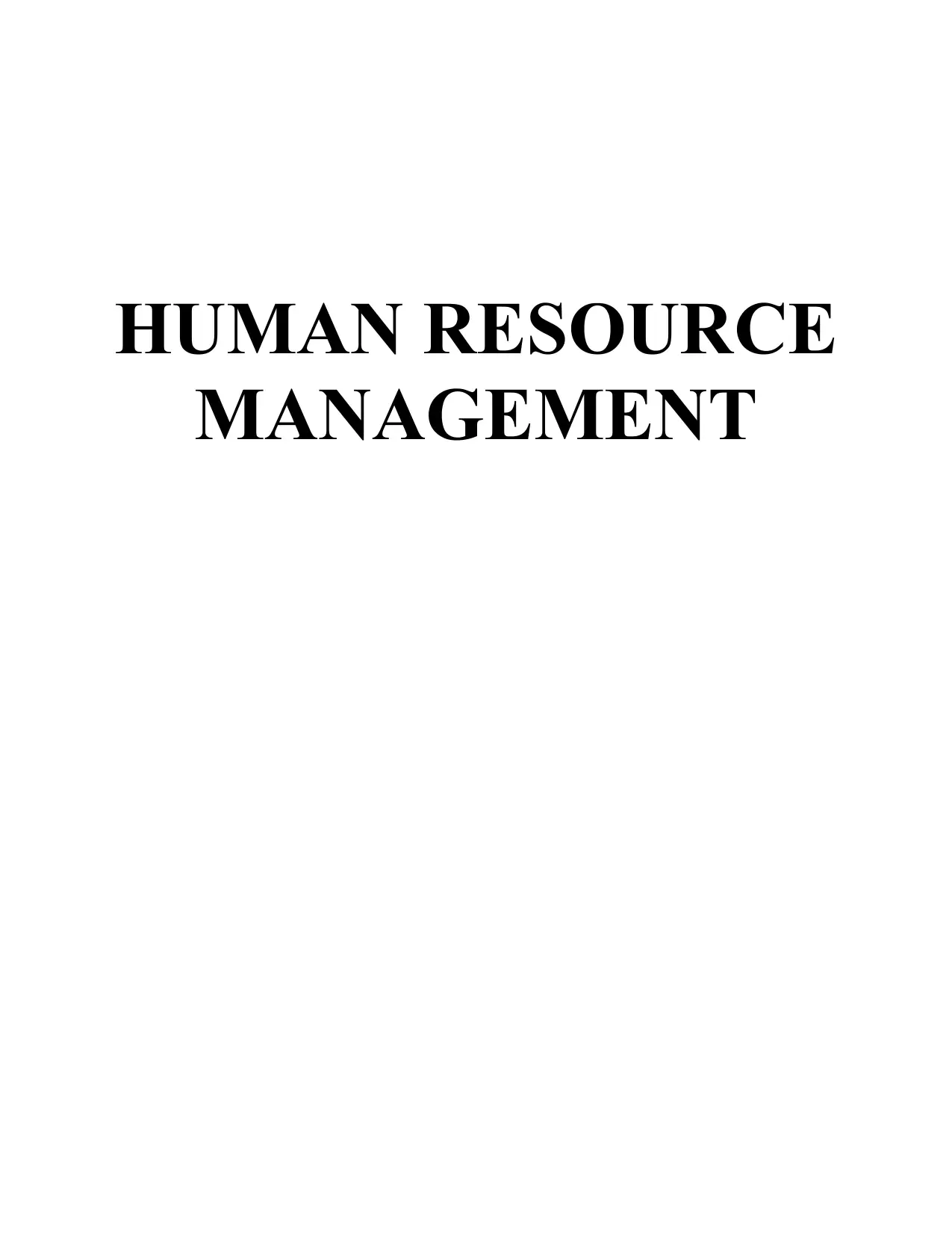
HUMAN RESOURCE
MANAGEMENT
MANAGEMENT
Paraphrase This Document
Need a fresh take? Get an instant paraphrase of this document with our AI Paraphraser
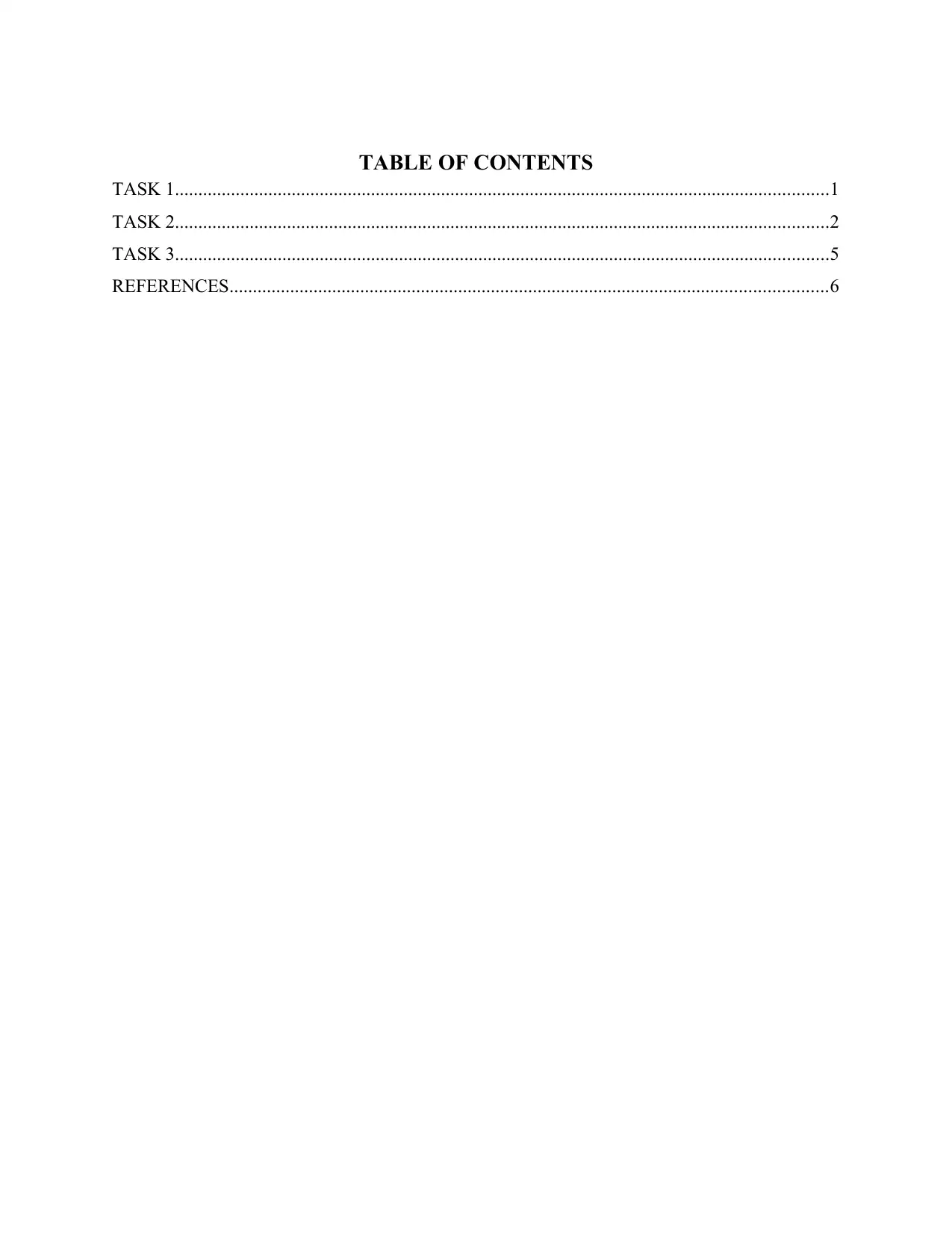
TABLE OF CONTENTS
TASK 1............................................................................................................................................1
TASK 2............................................................................................................................................2
TASK 3............................................................................................................................................5
REFERENCES................................................................................................................................6
TASK 1............................................................................................................................................1
TASK 2............................................................................................................................................2
TASK 3............................................................................................................................................5
REFERENCES................................................................................................................................6
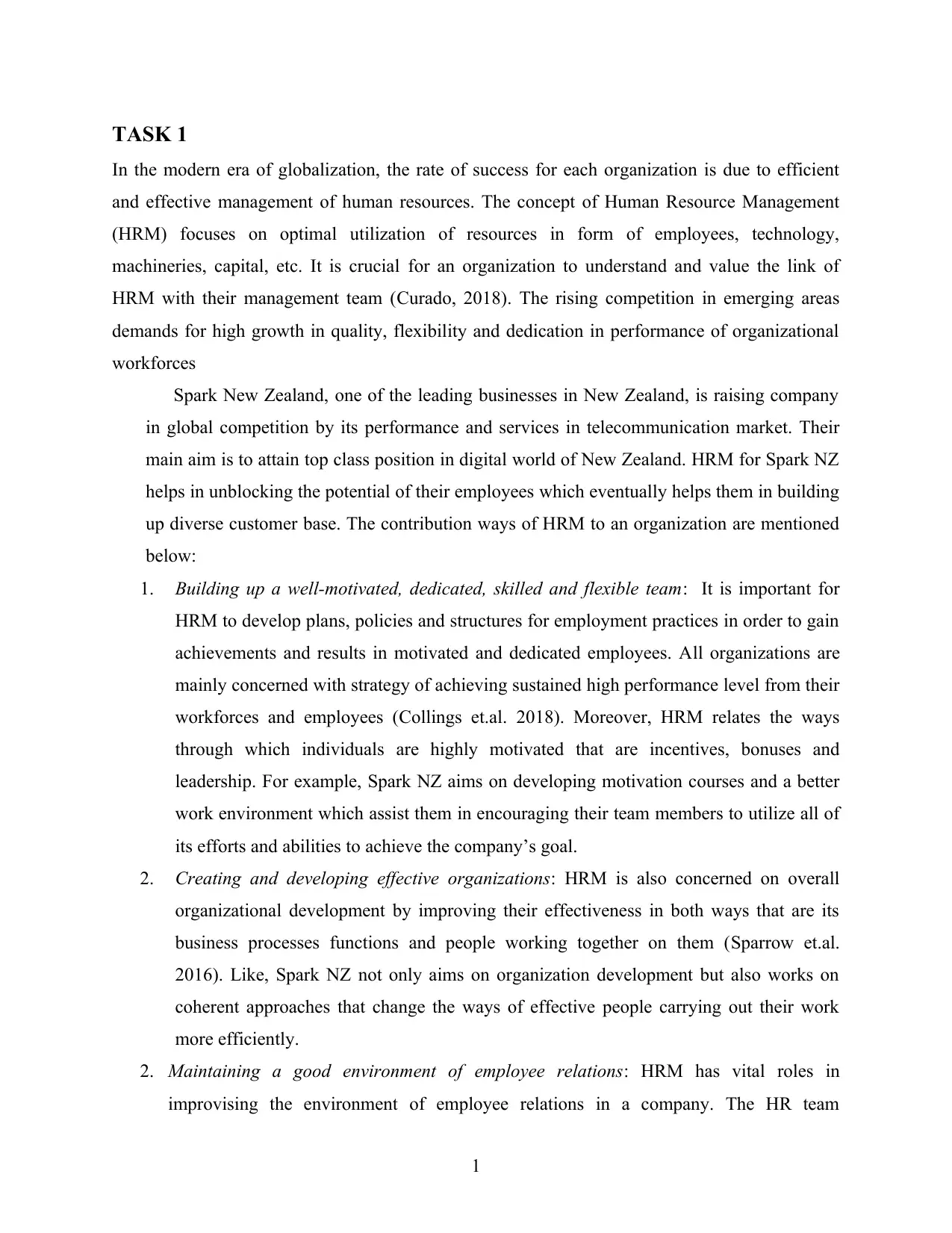
TASK 1
In the modern era of globalization, the rate of success for each organization is due to efficient
and effective management of human resources. The concept of Human Resource Management
(HRM) focuses on optimal utilization of resources in form of employees, technology,
machineries, capital, etc. It is crucial for an organization to understand and value the link of
HRM with their management team (Curado, 2018). The rising competition in emerging areas
demands for high growth in quality, flexibility and dedication in performance of organizational
workforces
Spark New Zealand, one of the leading businesses in New Zealand, is raising company
in global competition by its performance and services in telecommunication market. Their
main aim is to attain top class position in digital world of New Zealand. HRM for Spark NZ
helps in unblocking the potential of their employees which eventually helps them in building
up diverse customer base. The contribution ways of HRM to an organization are mentioned
below:
1. Building up a well-motivated, dedicated, skilled and flexible team: It is important for
HRM to develop plans, policies and structures for employment practices in order to gain
achievements and results in motivated and dedicated employees. All organizations are
mainly concerned with strategy of achieving sustained high performance level from their
workforces and employees (Collings et.al. 2018). Moreover, HRM relates the ways
through which individuals are highly motivated that are incentives, bonuses and
leadership. For example, Spark NZ aims on developing motivation courses and a better
work environment which assist them in encouraging their team members to utilize all of
its efforts and abilities to achieve the company’s goal.
2. Creating and developing effective organizations: HRM is also concerned on overall
organizational development by improving their effectiveness in both ways that are its
business processes functions and people working together on them (Sparrow et.al.
2016). Like, Spark NZ not only aims on organization development but also works on
coherent approaches that change the ways of effective people carrying out their work
more efficiently.
2. Maintaining a good environment of employee relations: HRM has vital roles in
improvising the environment of employee relations in a company. The HR team
1
In the modern era of globalization, the rate of success for each organization is due to efficient
and effective management of human resources. The concept of Human Resource Management
(HRM) focuses on optimal utilization of resources in form of employees, technology,
machineries, capital, etc. It is crucial for an organization to understand and value the link of
HRM with their management team (Curado, 2018). The rising competition in emerging areas
demands for high growth in quality, flexibility and dedication in performance of organizational
workforces
Spark New Zealand, one of the leading businesses in New Zealand, is raising company
in global competition by its performance and services in telecommunication market. Their
main aim is to attain top class position in digital world of New Zealand. HRM for Spark NZ
helps in unblocking the potential of their employees which eventually helps them in building
up diverse customer base. The contribution ways of HRM to an organization are mentioned
below:
1. Building up a well-motivated, dedicated, skilled and flexible team: It is important for
HRM to develop plans, policies and structures for employment practices in order to gain
achievements and results in motivated and dedicated employees. All organizations are
mainly concerned with strategy of achieving sustained high performance level from their
workforces and employees (Collings et.al. 2018). Moreover, HRM relates the ways
through which individuals are highly motivated that are incentives, bonuses and
leadership. For example, Spark NZ aims on developing motivation courses and a better
work environment which assist them in encouraging their team members to utilize all of
its efforts and abilities to achieve the company’s goal.
2. Creating and developing effective organizations: HRM is also concerned on overall
organizational development by improving their effectiveness in both ways that are its
business processes functions and people working together on them (Sparrow et.al.
2016). Like, Spark NZ not only aims on organization development but also works on
coherent approaches that change the ways of effective people carrying out their work
more efficiently.
2. Maintaining a good environment of employee relations: HRM has vital roles in
improvising the environment of employee relations in a company. The HR team
1
⊘ This is a preview!⊘
Do you want full access?
Subscribe today to unlock all pages.

Trusted by 1+ million students worldwide
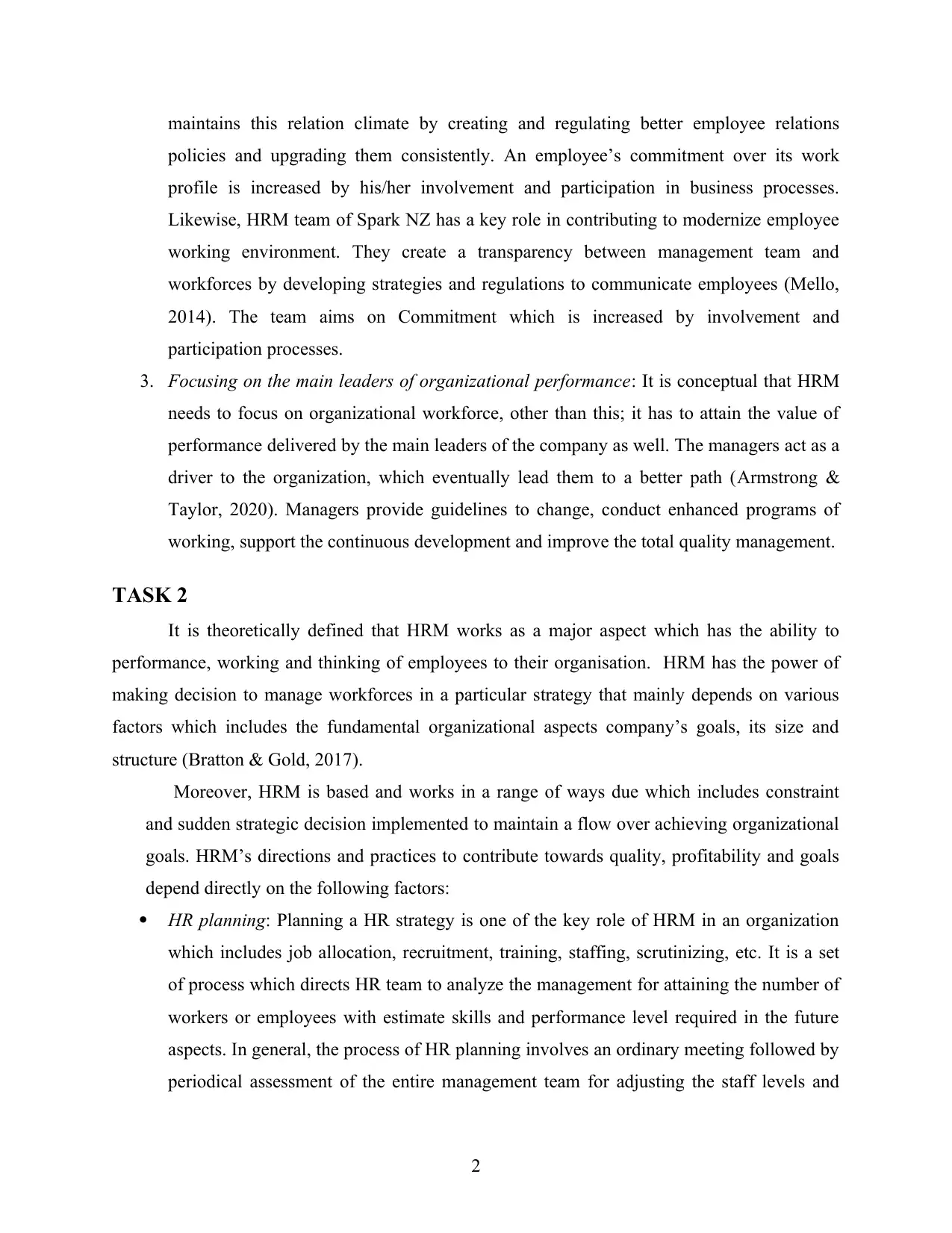
maintains this relation climate by creating and regulating better employee relations
policies and upgrading them consistently. An employee’s commitment over its work
profile is increased by his/her involvement and participation in business processes.
Likewise, HRM team of Spark NZ has a key role in contributing to modernize employee
working environment. They create a transparency between management team and
workforces by developing strategies and regulations to communicate employees (Mello,
2014). The team aims on Commitment which is increased by involvement and
participation processes.
3. Focusing on the main leaders of organizational performance: It is conceptual that HRM
needs to focus on organizational workforce, other than this; it has to attain the value of
performance delivered by the main leaders of the company as well. The managers act as a
driver to the organization, which eventually lead them to a better path (Armstrong &
Taylor, 2020). Managers provide guidelines to change, conduct enhanced programs of
working, support the continuous development and improve the total quality management.
TASK 2
It is theoretically defined that HRM works as a major aspect which has the ability to
performance, working and thinking of employees to their organisation. HRM has the power of
making decision to manage workforces in a particular strategy that mainly depends on various
factors which includes the fundamental organizational aspects company’s goals, its size and
structure (Bratton & Gold, 2017).
Moreover, HRM is based and works in a range of ways due which includes constraint
and sudden strategic decision implemented to maintain a flow over achieving organizational
goals. HRM’s directions and practices to contribute towards quality, profitability and goals
depend directly on the following factors:
HR planning: Planning a HR strategy is one of the key role of HRM in an organization
which includes job allocation, recruitment, training, staffing, scrutinizing, etc. It is a set
of process which directs HR team to analyze the management for attaining the number of
workers or employees with estimate skills and performance level required in the future
aspects. In general, the process of HR planning involves an ordinary meeting followed by
periodical assessment of the entire management team for adjusting the staff levels and
2
policies and upgrading them consistently. An employee’s commitment over its work
profile is increased by his/her involvement and participation in business processes.
Likewise, HRM team of Spark NZ has a key role in contributing to modernize employee
working environment. They create a transparency between management team and
workforces by developing strategies and regulations to communicate employees (Mello,
2014). The team aims on Commitment which is increased by involvement and
participation processes.
3. Focusing on the main leaders of organizational performance: It is conceptual that HRM
needs to focus on organizational workforce, other than this; it has to attain the value of
performance delivered by the main leaders of the company as well. The managers act as a
driver to the organization, which eventually lead them to a better path (Armstrong &
Taylor, 2020). Managers provide guidelines to change, conduct enhanced programs of
working, support the continuous development and improve the total quality management.
TASK 2
It is theoretically defined that HRM works as a major aspect which has the ability to
performance, working and thinking of employees to their organisation. HRM has the power of
making decision to manage workforces in a particular strategy that mainly depends on various
factors which includes the fundamental organizational aspects company’s goals, its size and
structure (Bratton & Gold, 2017).
Moreover, HRM is based and works in a range of ways due which includes constraint
and sudden strategic decision implemented to maintain a flow over achieving organizational
goals. HRM’s directions and practices to contribute towards quality, profitability and goals
depend directly on the following factors:
HR planning: Planning a HR strategy is one of the key role of HRM in an organization
which includes job allocation, recruitment, training, staffing, scrutinizing, etc. It is a set
of process which directs HR team to analyze the management for attaining the number of
workers or employees with estimate skills and performance level required in the future
aspects. In general, the process of HR planning involves an ordinary meeting followed by
periodical assessment of the entire management team for adjusting the staff levels and
2
Paraphrase This Document
Need a fresh take? Get an instant paraphrase of this document with our AI Paraphraser
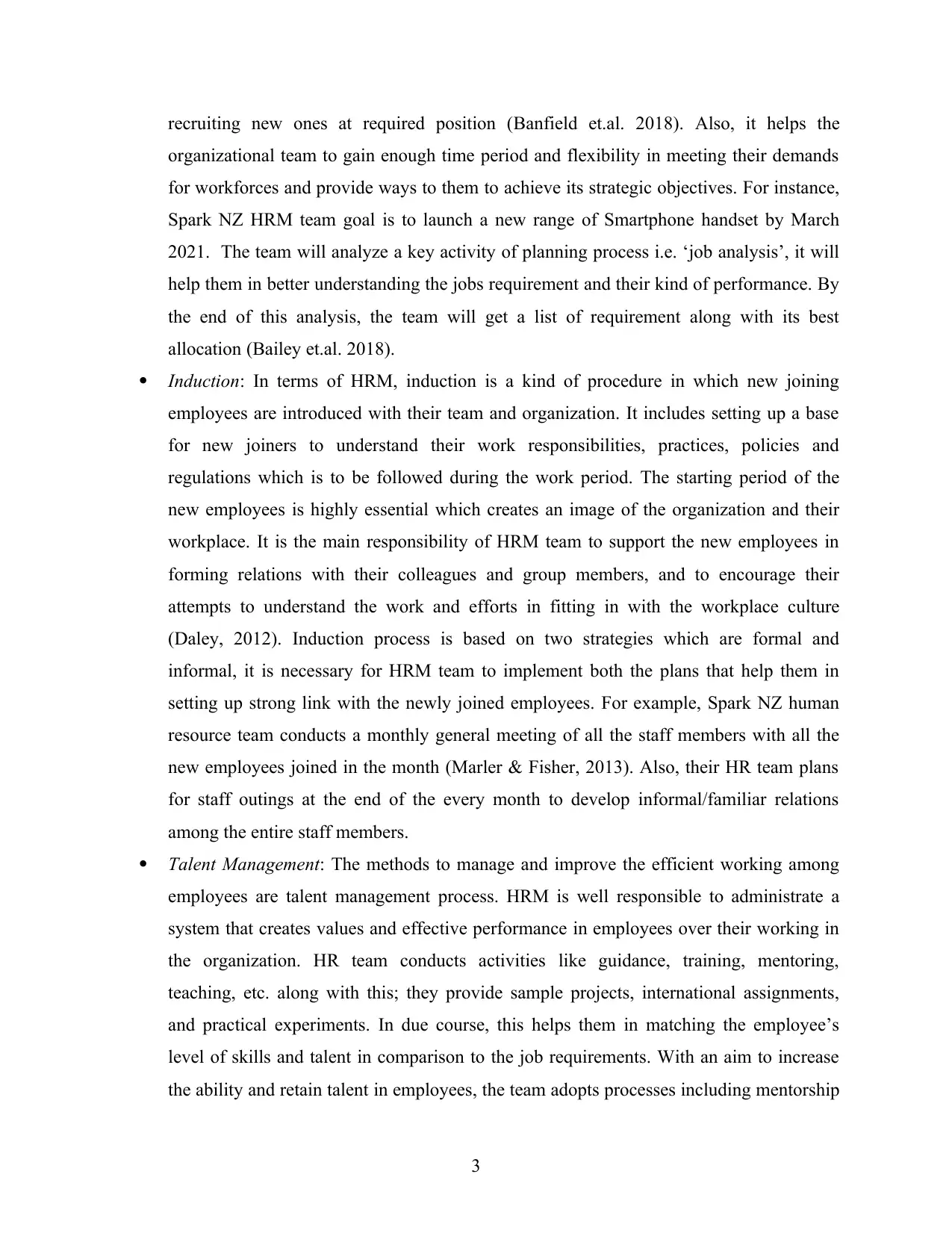
recruiting new ones at required position (Banfield et.al. 2018). Also, it helps the
organizational team to gain enough time period and flexibility in meeting their demands
for workforces and provide ways to them to achieve its strategic objectives. For instance,
Spark NZ HRM team goal is to launch a new range of Smartphone handset by March
2021. The team will analyze a key activity of planning process i.e. ‘job analysis’, it will
help them in better understanding the jobs requirement and their kind of performance. By
the end of this analysis, the team will get a list of requirement along with its best
allocation (Bailey et.al. 2018).
Induction: In terms of HRM, induction is a kind of procedure in which new joining
employees are introduced with their team and organization. It includes setting up a base
for new joiners to understand their work responsibilities, practices, policies and
regulations which is to be followed during the work period. The starting period of the
new employees is highly essential which creates an image of the organization and their
workplace. It is the main responsibility of HRM team to support the new employees in
forming relations with their colleagues and group members, and to encourage their
attempts to understand the work and efforts in fitting in with the workplace culture
(Daley, 2012). Induction process is based on two strategies which are formal and
informal, it is necessary for HRM team to implement both the plans that help them in
setting up strong link with the newly joined employees. For example, Spark NZ human
resource team conducts a monthly general meeting of all the staff members with all the
new employees joined in the month (Marler & Fisher, 2013). Also, their HR team plans
for staff outings at the end of the every month to develop informal/familiar relations
among the entire staff members.
Talent Management: The methods to manage and improve the efficient working among
employees are talent management process. HRM is well responsible to administrate a
system that creates values and effective performance in employees over their working in
the organization. HR team conducts activities like guidance, training, mentoring,
teaching, etc. along with this; they provide sample projects, international assignments,
and practical experiments. In due course, this helps them in matching the employee’s
level of skills and talent in comparison to the job requirements. With an aim to increase
the ability and retain talent in employees, the team adopts processes including mentorship
3
organizational team to gain enough time period and flexibility in meeting their demands
for workforces and provide ways to them to achieve its strategic objectives. For instance,
Spark NZ HRM team goal is to launch a new range of Smartphone handset by March
2021. The team will analyze a key activity of planning process i.e. ‘job analysis’, it will
help them in better understanding the jobs requirement and their kind of performance. By
the end of this analysis, the team will get a list of requirement along with its best
allocation (Bailey et.al. 2018).
Induction: In terms of HRM, induction is a kind of procedure in which new joining
employees are introduced with their team and organization. It includes setting up a base
for new joiners to understand their work responsibilities, practices, policies and
regulations which is to be followed during the work period. The starting period of the
new employees is highly essential which creates an image of the organization and their
workplace. It is the main responsibility of HRM team to support the new employees in
forming relations with their colleagues and group members, and to encourage their
attempts to understand the work and efforts in fitting in with the workplace culture
(Daley, 2012). Induction process is based on two strategies which are formal and
informal, it is necessary for HRM team to implement both the plans that help them in
setting up strong link with the newly joined employees. For example, Spark NZ human
resource team conducts a monthly general meeting of all the staff members with all the
new employees joined in the month (Marler & Fisher, 2013). Also, their HR team plans
for staff outings at the end of the every month to develop informal/familiar relations
among the entire staff members.
Talent Management: The methods to manage and improve the efficient working among
employees are talent management process. HRM is well responsible to administrate a
system that creates values and effective performance in employees over their working in
the organization. HR team conducts activities like guidance, training, mentoring,
teaching, etc. along with this; they provide sample projects, international assignments,
and practical experiments. In due course, this helps them in matching the employee’s
level of skills and talent in comparison to the job requirements. With an aim to increase
the ability and retain talent in employees, the team adopts processes including mentorship
3
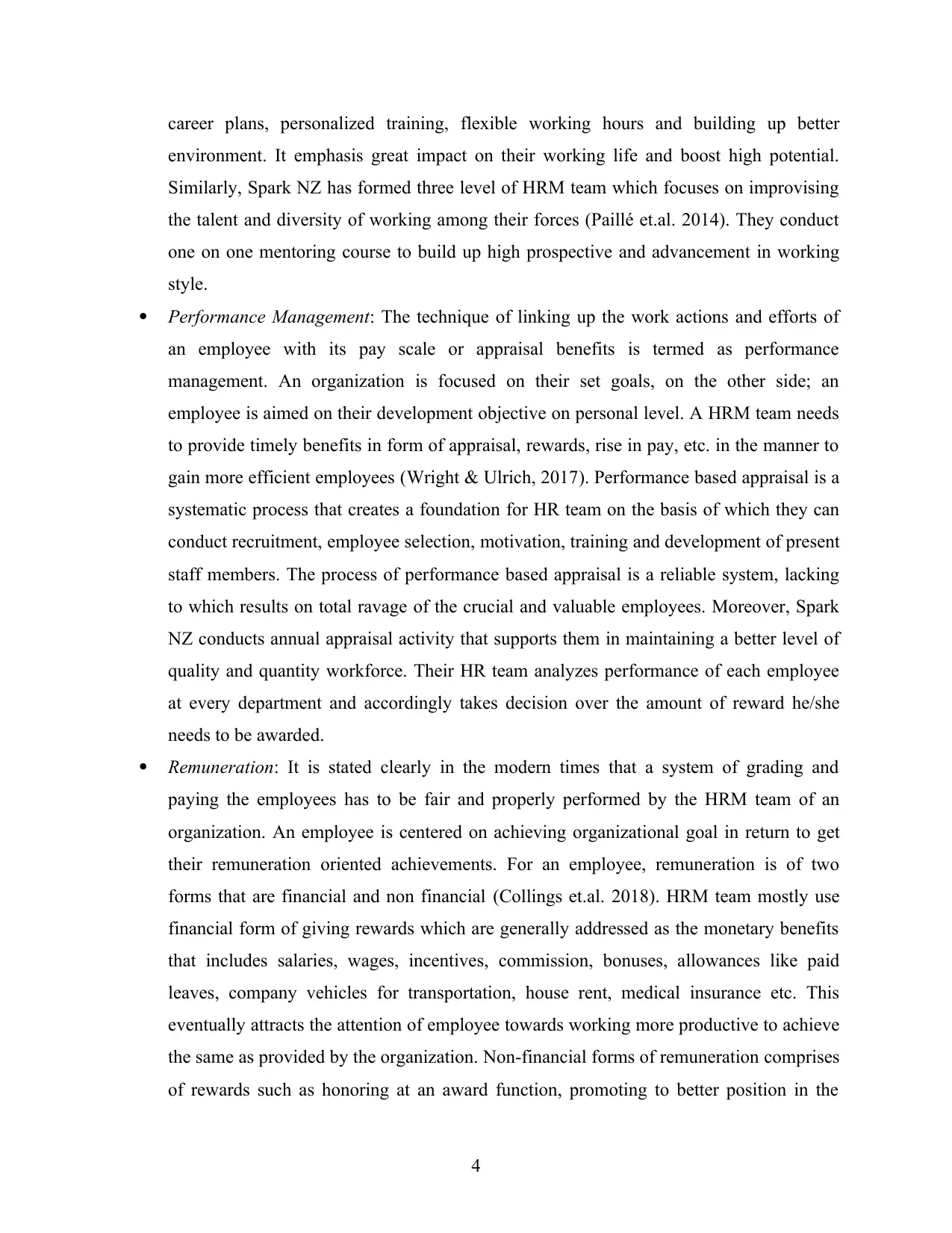
career plans, personalized training, flexible working hours and building up better
environment. It emphasis great impact on their working life and boost high potential.
Similarly, Spark NZ has formed three level of HRM team which focuses on improvising
the talent and diversity of working among their forces (Paillé et.al. 2014). They conduct
one on one mentoring course to build up high prospective and advancement in working
style.
Performance Management: The technique of linking up the work actions and efforts of
an employee with its pay scale or appraisal benefits is termed as performance
management. An organization is focused on their set goals, on the other side; an
employee is aimed on their development objective on personal level. A HRM team needs
to provide timely benefits in form of appraisal, rewards, rise in pay, etc. in the manner to
gain more efficient employees (Wright & Ulrich, 2017). Performance based appraisal is a
systematic process that creates a foundation for HR team on the basis of which they can
conduct recruitment, employee selection, motivation, training and development of present
staff members. The process of performance based appraisal is a reliable system, lacking
to which results on total ravage of the crucial and valuable employees. Moreover, Spark
NZ conducts annual appraisal activity that supports them in maintaining a better level of
quality and quantity workforce. Their HR team analyzes performance of each employee
at every department and accordingly takes decision over the amount of reward he/she
needs to be awarded.
Remuneration: It is stated clearly in the modern times that a system of grading and
paying the employees has to be fair and properly performed by the HRM team of an
organization. An employee is centered on achieving organizational goal in return to get
their remuneration oriented achievements. For an employee, remuneration is of two
forms that are financial and non financial (Collings et.al. 2018). HRM team mostly use
financial form of giving rewards which are generally addressed as the monetary benefits
that includes salaries, wages, incentives, commission, bonuses, allowances like paid
leaves, company vehicles for transportation, house rent, medical insurance etc. This
eventually attracts the attention of employee towards working more productive to achieve
the same as provided by the organization. Non-financial forms of remuneration comprises
of rewards such as honoring at an award function, promoting to better position in the
4
environment. It emphasis great impact on their working life and boost high potential.
Similarly, Spark NZ has formed three level of HRM team which focuses on improvising
the talent and diversity of working among their forces (Paillé et.al. 2014). They conduct
one on one mentoring course to build up high prospective and advancement in working
style.
Performance Management: The technique of linking up the work actions and efforts of
an employee with its pay scale or appraisal benefits is termed as performance
management. An organization is focused on their set goals, on the other side; an
employee is aimed on their development objective on personal level. A HRM team needs
to provide timely benefits in form of appraisal, rewards, rise in pay, etc. in the manner to
gain more efficient employees (Wright & Ulrich, 2017). Performance based appraisal is a
systematic process that creates a foundation for HR team on the basis of which they can
conduct recruitment, employee selection, motivation, training and development of present
staff members. The process of performance based appraisal is a reliable system, lacking
to which results on total ravage of the crucial and valuable employees. Moreover, Spark
NZ conducts annual appraisal activity that supports them in maintaining a better level of
quality and quantity workforce. Their HR team analyzes performance of each employee
at every department and accordingly takes decision over the amount of reward he/she
needs to be awarded.
Remuneration: It is stated clearly in the modern times that a system of grading and
paying the employees has to be fair and properly performed by the HRM team of an
organization. An employee is centered on achieving organizational goal in return to get
their remuneration oriented achievements. For an employee, remuneration is of two
forms that are financial and non financial (Collings et.al. 2018). HRM team mostly use
financial form of giving rewards which are generally addressed as the monetary benefits
that includes salaries, wages, incentives, commission, bonuses, allowances like paid
leaves, company vehicles for transportation, house rent, medical insurance etc. This
eventually attracts the attention of employee towards working more productive to achieve
the same as provided by the organization. Non-financial forms of remuneration comprises
of rewards such as honoring at an award function, promoting to better position in the
4
⊘ This is a preview!⊘
Do you want full access?
Subscribe today to unlock all pages.

Trusted by 1+ million students worldwide
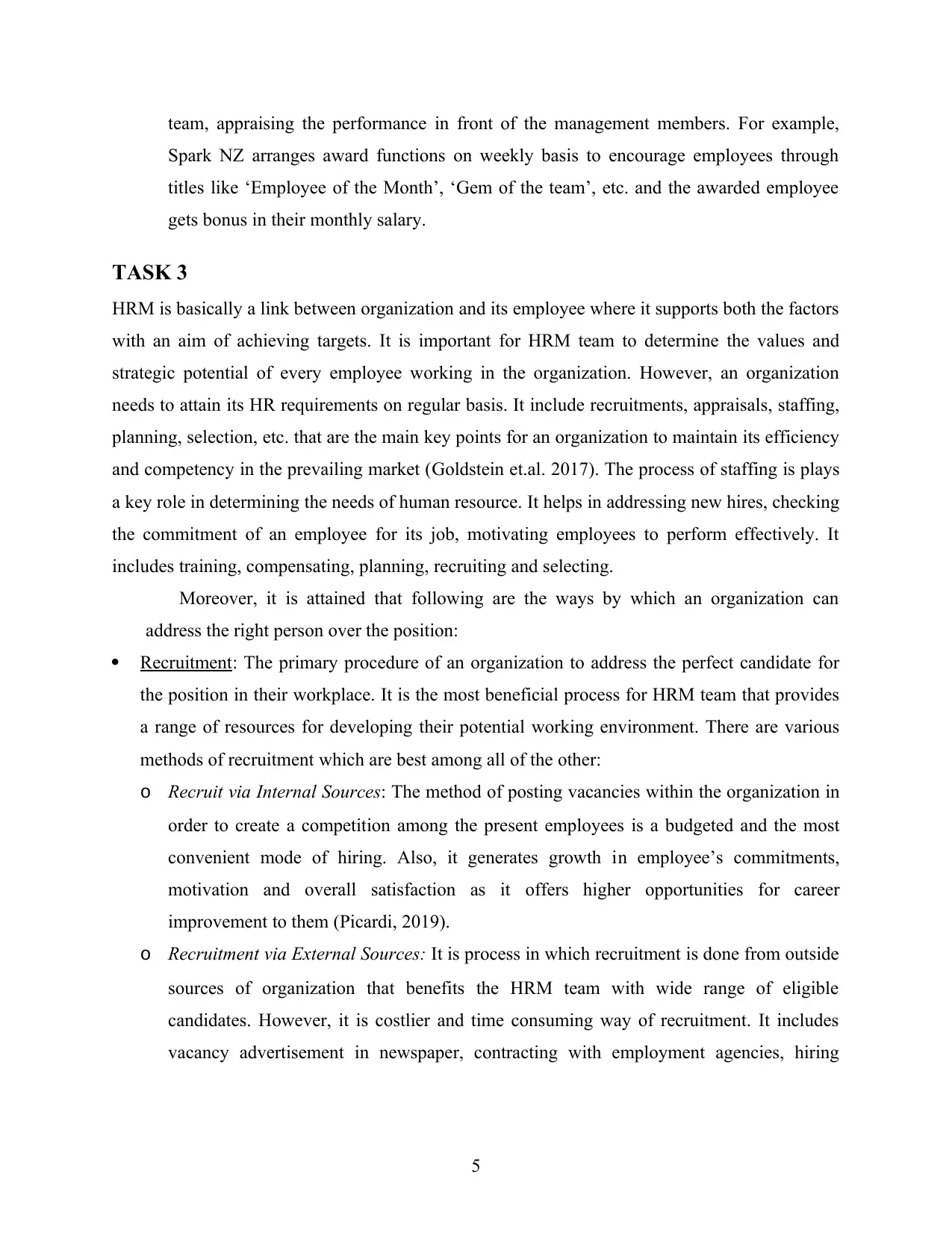
team, appraising the performance in front of the management members. For example,
Spark NZ arranges award functions on weekly basis to encourage employees through
titles like ‘Employee of the Month’, ‘Gem of the team’, etc. and the awarded employee
gets bonus in their monthly salary.
TASK 3
HRM is basically a link between organization and its employee where it supports both the factors
with an aim of achieving targets. It is important for HRM team to determine the values and
strategic potential of every employee working in the organization. However, an organization
needs to attain its HR requirements on regular basis. It include recruitments, appraisals, staffing,
planning, selection, etc. that are the main key points for an organization to maintain its efficiency
and competency in the prevailing market (Goldstein et.al. 2017). The process of staffing is plays
a key role in determining the needs of human resource. It helps in addressing new hires, checking
the commitment of an employee for its job, motivating employees to perform effectively. It
includes training, compensating, planning, recruiting and selecting.
Moreover, it is attained that following are the ways by which an organization can
address the right person over the position:
Recruitment: The primary procedure of an organization to address the perfect candidate for
the position in their workplace. It is the most beneficial process for HRM team that provides
a range of resources for developing their potential working environment. There are various
methods of recruitment which are best among all of the other:
o Recruit via Internal Sources: The method of posting vacancies within the organization in
order to create a competition among the present employees is a budgeted and the most
convenient mode of hiring. Also, it generates growth in employee’s commitments,
motivation and overall satisfaction as it offers higher opportunities for career
improvement to them (Picardi, 2019).
o Recruitment via External Sources: It is process in which recruitment is done from outside
sources of organization that benefits the HRM team with wide range of eligible
candidates. However, it is costlier and time consuming way of recruitment. It includes
vacancy advertisement in newspaper, contracting with employment agencies, hiring
5
Spark NZ arranges award functions on weekly basis to encourage employees through
titles like ‘Employee of the Month’, ‘Gem of the team’, etc. and the awarded employee
gets bonus in their monthly salary.
TASK 3
HRM is basically a link between organization and its employee where it supports both the factors
with an aim of achieving targets. It is important for HRM team to determine the values and
strategic potential of every employee working in the organization. However, an organization
needs to attain its HR requirements on regular basis. It include recruitments, appraisals, staffing,
planning, selection, etc. that are the main key points for an organization to maintain its efficiency
and competency in the prevailing market (Goldstein et.al. 2017). The process of staffing is plays
a key role in determining the needs of human resource. It helps in addressing new hires, checking
the commitment of an employee for its job, motivating employees to perform effectively. It
includes training, compensating, planning, recruiting and selecting.
Moreover, it is attained that following are the ways by which an organization can
address the right person over the position:
Recruitment: The primary procedure of an organization to address the perfect candidate for
the position in their workplace. It is the most beneficial process for HRM team that provides
a range of resources for developing their potential working environment. There are various
methods of recruitment which are best among all of the other:
o Recruit via Internal Sources: The method of posting vacancies within the organization in
order to create a competition among the present employees is a budgeted and the most
convenient mode of hiring. Also, it generates growth in employee’s commitments,
motivation and overall satisfaction as it offers higher opportunities for career
improvement to them (Picardi, 2019).
o Recruitment via External Sources: It is process in which recruitment is done from outside
sources of organization that benefits the HRM team with wide range of eligible
candidates. However, it is costlier and time consuming way of recruitment. It includes
vacancy advertisement in newspaper, contracting with employment agencies, hiring
5
Paraphrase This Document
Need a fresh take? Get an instant paraphrase of this document with our AI Paraphraser
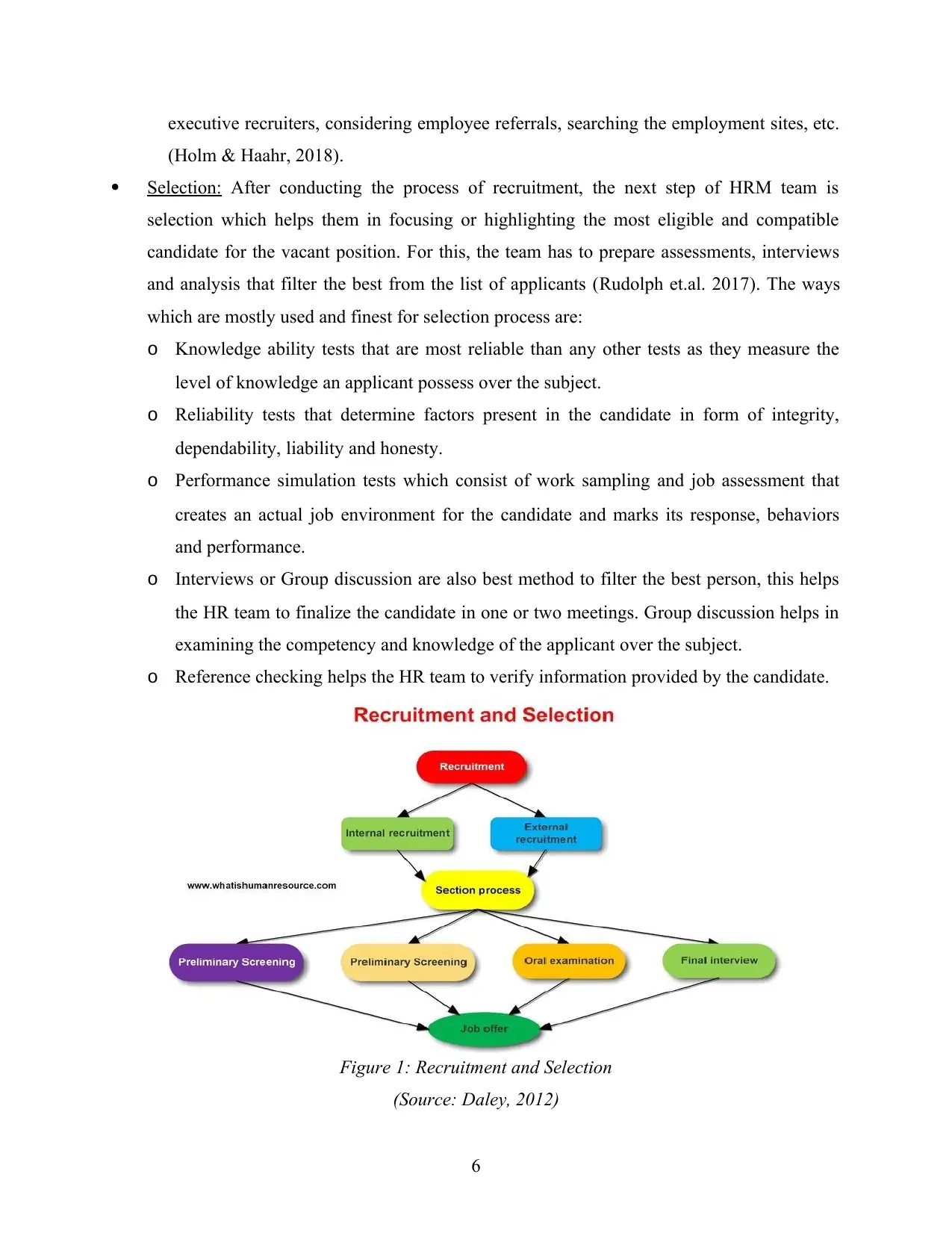
executive recruiters, considering employee referrals, searching the employment sites, etc.
(Holm & Haahr, 2018).
Selection: After conducting the process of recruitment, the next step of HRM team is
selection which helps them in focusing or highlighting the most eligible and compatible
candidate for the vacant position. For this, the team has to prepare assessments, interviews
and analysis that filter the best from the list of applicants (Rudolph et.al. 2017). The ways
which are mostly used and finest for selection process are:
o Knowledge ability tests that are most reliable than any other tests as they measure the
level of knowledge an applicant possess over the subject.
o Reliability tests that determine factors present in the candidate in form of integrity,
dependability, liability and honesty.
o Performance simulation tests which consist of work sampling and job assessment that
creates an actual job environment for the candidate and marks its response, behaviors
and performance.
o Interviews or Group discussion are also best method to filter the best person, this helps
the HR team to finalize the candidate in one or two meetings. Group discussion helps in
examining the competency and knowledge of the applicant over the subject.
o Reference checking helps the HR team to verify information provided by the candidate.
Figure 1: Recruitment and Selection
(Source: Daley, 2012)
6
(Holm & Haahr, 2018).
Selection: After conducting the process of recruitment, the next step of HRM team is
selection which helps them in focusing or highlighting the most eligible and compatible
candidate for the vacant position. For this, the team has to prepare assessments, interviews
and analysis that filter the best from the list of applicants (Rudolph et.al. 2017). The ways
which are mostly used and finest for selection process are:
o Knowledge ability tests that are most reliable than any other tests as they measure the
level of knowledge an applicant possess over the subject.
o Reliability tests that determine factors present in the candidate in form of integrity,
dependability, liability and honesty.
o Performance simulation tests which consist of work sampling and job assessment that
creates an actual job environment for the candidate and marks its response, behaviors
and performance.
o Interviews or Group discussion are also best method to filter the best person, this helps
the HR team to finalize the candidate in one or two meetings. Group discussion helps in
examining the competency and knowledge of the applicant over the subject.
o Reference checking helps the HR team to verify information provided by the candidate.
Figure 1: Recruitment and Selection
(Source: Daley, 2012)
6

7
⊘ This is a preview!⊘
Do you want full access?
Subscribe today to unlock all pages.

Trusted by 1+ million students worldwide
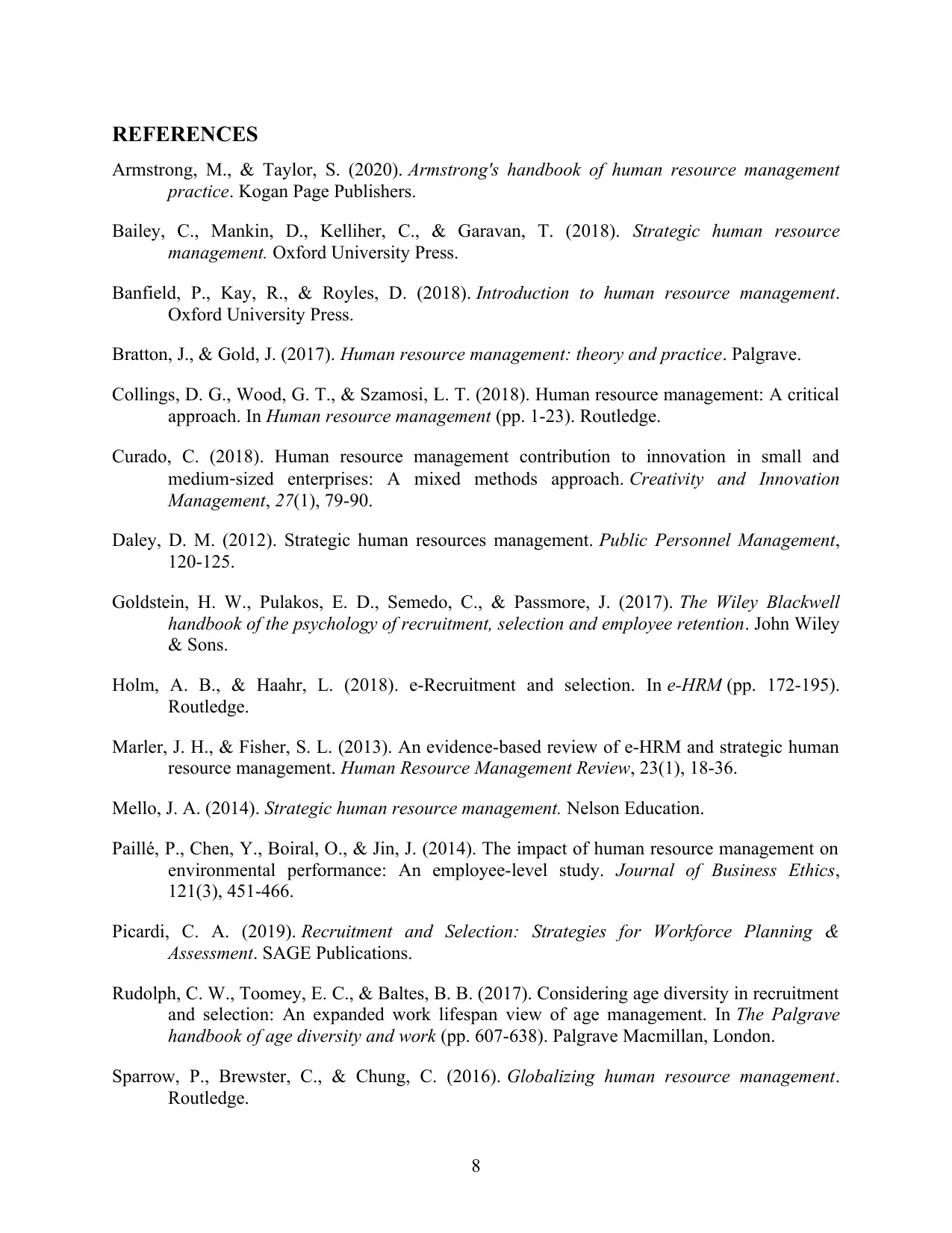
REFERENCES
Armstrong, M., & Taylor, S. (2020). Armstrong's handbook of human resource management
practice. Kogan Page Publishers.
Bailey, C., Mankin, D., Kelliher, C., & Garavan, T. (2018). Strategic human resource
management. Oxford University Press.
Banfield, P., Kay, R., & Royles, D. (2018). Introduction to human resource management.
Oxford University Press.
Bratton, J., & Gold, J. (2017). Human resource management: theory and practice. Palgrave.
Collings, D. G., Wood, G. T., & Szamosi, L. T. (2018). Human resource management: A critical
approach. In Human resource management (pp. 1-23). Routledge.
Curado, C. (2018). Human resource management contribution to innovation in small and
medium‐sized enterprises: A mixed methods approach. Creativity and Innovation
Management, 27(1), 79-90.
Daley, D. M. (2012). Strategic human resources management. Public Personnel Management,
120-125.
Goldstein, H. W., Pulakos, E. D., Semedo, C., & Passmore, J. (2017). The Wiley Blackwell
handbook of the psychology of recruitment, selection and employee retention. John Wiley
& Sons.
Holm, A. B., & Haahr, L. (2018). e-Recruitment and selection. In e-HRM (pp. 172-195).
Routledge.
Marler, J. H., & Fisher, S. L. (2013). An evidence-based review of e-HRM and strategic human
resource management. Human Resource Management Review, 23(1), 18-36.
Mello, J. A. (2014). Strategic human resource management. Nelson Education.
Paillé, P., Chen, Y., Boiral, O., & Jin, J. (2014). The impact of human resource management on
environmental performance: An employee-level study. Journal of Business Ethics,
121(3), 451-466.
Picardi, C. A. (2019). Recruitment and Selection: Strategies for Workforce Planning &
Assessment. SAGE Publications.
Rudolph, C. W., Toomey, E. C., & Baltes, B. B. (2017). Considering age diversity in recruitment
and selection: An expanded work lifespan view of age management. In The Palgrave
handbook of age diversity and work (pp. 607-638). Palgrave Macmillan, London.
Sparrow, P., Brewster, C., & Chung, C. (2016). Globalizing human resource management.
Routledge.
8
Armstrong, M., & Taylor, S. (2020). Armstrong's handbook of human resource management
practice. Kogan Page Publishers.
Bailey, C., Mankin, D., Kelliher, C., & Garavan, T. (2018). Strategic human resource
management. Oxford University Press.
Banfield, P., Kay, R., & Royles, D. (2018). Introduction to human resource management.
Oxford University Press.
Bratton, J., & Gold, J. (2017). Human resource management: theory and practice. Palgrave.
Collings, D. G., Wood, G. T., & Szamosi, L. T. (2018). Human resource management: A critical
approach. In Human resource management (pp. 1-23). Routledge.
Curado, C. (2018). Human resource management contribution to innovation in small and
medium‐sized enterprises: A mixed methods approach. Creativity and Innovation
Management, 27(1), 79-90.
Daley, D. M. (2012). Strategic human resources management. Public Personnel Management,
120-125.
Goldstein, H. W., Pulakos, E. D., Semedo, C., & Passmore, J. (2017). The Wiley Blackwell
handbook of the psychology of recruitment, selection and employee retention. John Wiley
& Sons.
Holm, A. B., & Haahr, L. (2018). e-Recruitment and selection. In e-HRM (pp. 172-195).
Routledge.
Marler, J. H., & Fisher, S. L. (2013). An evidence-based review of e-HRM and strategic human
resource management. Human Resource Management Review, 23(1), 18-36.
Mello, J. A. (2014). Strategic human resource management. Nelson Education.
Paillé, P., Chen, Y., Boiral, O., & Jin, J. (2014). The impact of human resource management on
environmental performance: An employee-level study. Journal of Business Ethics,
121(3), 451-466.
Picardi, C. A. (2019). Recruitment and Selection: Strategies for Workforce Planning &
Assessment. SAGE Publications.
Rudolph, C. W., Toomey, E. C., & Baltes, B. B. (2017). Considering age diversity in recruitment
and selection: An expanded work lifespan view of age management. In The Palgrave
handbook of age diversity and work (pp. 607-638). Palgrave Macmillan, London.
Sparrow, P., Brewster, C., & Chung, C. (2016). Globalizing human resource management.
Routledge.
8
1 out of 10
Related Documents
Your All-in-One AI-Powered Toolkit for Academic Success.
+13062052269
info@desklib.com
Available 24*7 on WhatsApp / Email
![[object Object]](/_next/static/media/star-bottom.7253800d.svg)
Unlock your academic potential
Copyright © 2020–2025 A2Z Services. All Rights Reserved. Developed and managed by ZUCOL.




